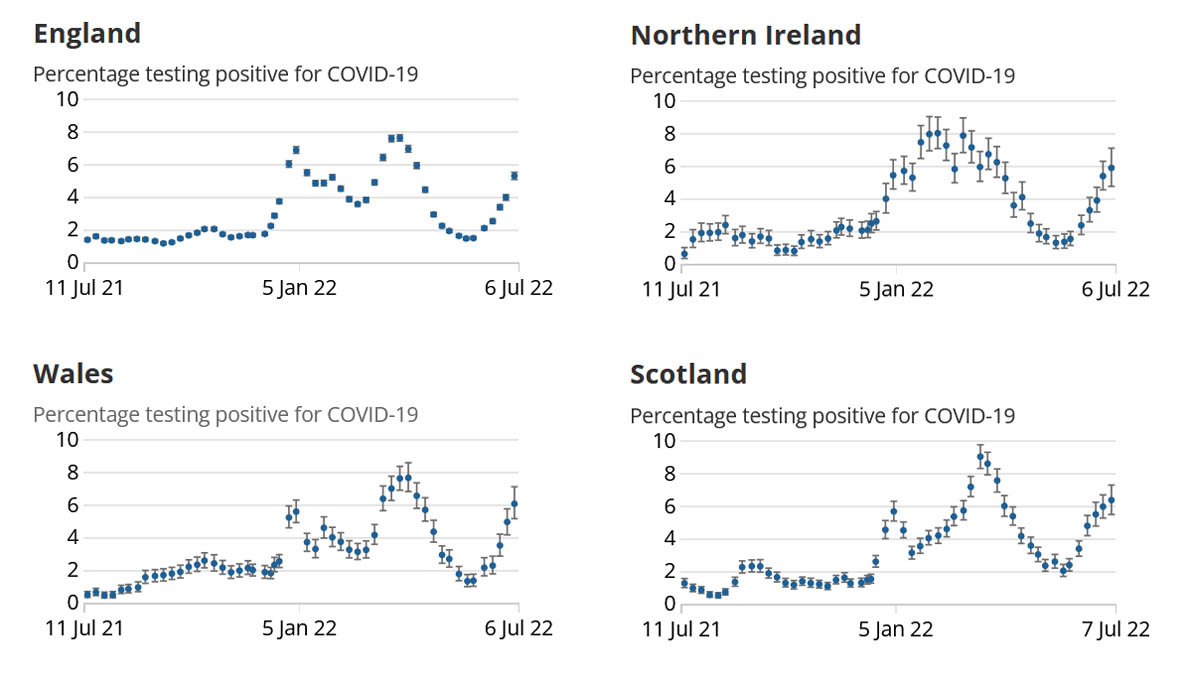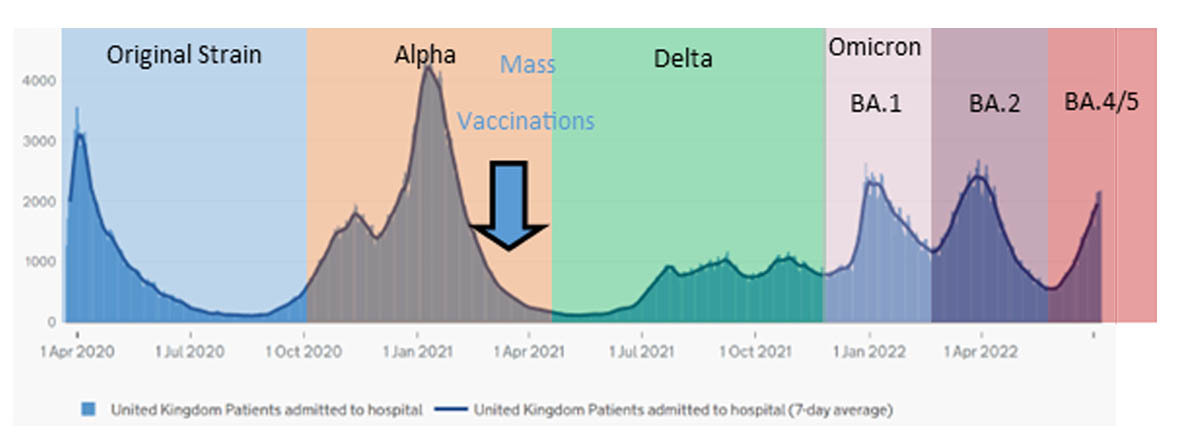‘Are we in a new Covid-19 wave?’ asks molecular biologist, Emma Monk
This week the Office for National Statistics (ONS) announced we had hit a horrifying milestone: recording 200,000 Covid deaths in the UK since the start of the pandemic. But look around the shops and on the trains and you’d be forgiven for thinking Covid-19 was all done and dusted.
Few people now seem to be taking any kind of Covid precaution, yet the latest ONS infection survey shows that, in the week ending July 7, 2022, nearly three million people in England were infected with Covid-19. That’s 800,000 more than the week before.
Approximately one in 20 people are currently infected with Covid-19, up from one in 50 just four weeks ago. There is no doubt that we are in yet another Covid-19 wave, the third so far this year.
While deaths from Covid remain much lower than during pre-vaccination times, deaths are currently 12 per cent higher than is normal for this time of year.
The ONS weekly survey provides a national estimate of figures, based on a large survey of people who are tested, whether or not they have symptoms. It is currently our only accurate measure of Covid-19 cases in the community.
Free testing is no longer available and even if you do test positive, there is no route available to report a positive Covid-19 test.

What is driving this wave?
The current wave is being driven by the BA.4 and BA.5 variants of Omicron. Recent research carried out in Japan found that BA.4/5 was more transmissible than BA.2, better able to infect lung cells than BA.2, more deadly in hamsters than BA.2, and able to escape immunity from vaccinations and immunity from previous Omicron infections.
So if you caught Covid-19 in January or March this year you’ll still have little protection against catching Covid-19 during this wave. And this particular strain of Covid-19 is both more contagious and more severe than other Omicron variants.
The Covid Hospital Admission data from the Coronavirus dashboard makes it is easy to see the various waves and which variants drove them.

Three key points stand out when you look at that image:
- How impactful the mass vaccination programme was, in reducing the burden on hospitals;
- How, despite Omicron being portrayed as ‘mild’ by many, the burden on the NHS has been far greater than during the more ‘deadly’ Delta wave;
- Finally, how quickly the virus is now mutating to create new and more frequent waves.
Will this be the last wave?
Sadly, just as with the previous five waves, we can say with absolute certainty that this will not be the last. It will not be the final hurrah that lets us achieve that mythical ‘herd immunity’. Omicron, in particular, has shown us that herd immunity is no more than a pipe dream.
A recent study found that Omicron is ‘an especially stealthy immune evader’, with an ability both to evade vaccine protection and to fail to provide much protection against future Covid-19 infections
At the start of this wave, over 99 per cent of people in the UK had SARS-CoV-2 antibodies, acquired through either vaccination or infection, and yet three million people in the UK are now infected as we head towards the peak of this wave.
This should be conclusive evidence that people will just keep getting infected with Covid-19, again and again, over the coming months and years. Herd immunity isn’t going to save us, and sadly, vaccinations alone aren’t going to prevent it.
Vaccinations are still doing a fantastic job of keeping the majority of patients out of hospital, but their effects are waning, particularly as the months pass since receiving the last dose.
Don’t we need to just ‘learn to live with it now’?
Many argue that it is simply time to accept Covid-19 is never going away and we should just treat it like any other seasonal virus. However, there are several major issues with that idea.
First, the fact that we are in the midst of a third wave this year alone, in the middle of summer, should dispel the myth that SARS-CoV-2 (Covid) is a seasonal virus.
There is only one flu season each year, which allows us to plan and prepare for it. We have got very good at predicting which variant of flu is likely to be dominant each winter and we tailor our flu vaccines accordingly. NB: living with flu doesn’t mean ignoring it and hoping for the best!
With SARS-CoV-2 mutating at the rate it is, and with no let-up between waves, there is currently no chance we can tailor vaccines fast enough, let alone prepare and shore up the Health Service ready for the next wave of Covid-19. The seasonal coronaviruses that cause the common cold generally reinfect people every three years, during winter. A far cry from the two or three reinfections a year we are looking at with Covid-19.
Second, on any metric you can measure, Covid-19 is worse than flu; It is more contagious (BA.4/5 is now thought to be as contagious as measles, the most contagious human virus we currently encounter, around 10-15 times as contagious as flu) and it has killed more people in 2020 and 2021 than flu and pneumonia combined killed in any year since 1918/9. So far in 2022, Covid-19 has been on the death certificates of over 20,000 people. In comparison, flu killed 1,598 people in 2018 and 1,223 in 2019.
Third, the increased health burden (and therefore economic burden) society is facing from both Long Covid and the increased risk of major health problems is not a matter that can or should be ignored. A recent paper showed that compared with a first Covid-19 infection, reinfection increases the risk of problems ranging from heart and lung disorders, clotting issues, diabetes, kidney disorders and even mental health disorders. The increased risks were still there six months after the reinfections and the research showed that being infected three times increased the risks further.
Each infection also increases the risk of suffering Long Covid. An estimated 2 million people in the UK are currently suffering symptoms of Long Covid, with 1.4 million of them reporting that it adversely affects their day-to-day living. A third of the Long Covid cases resulted from Omicron infections – so nearly 650,000 people are facing ongoing health problems as a result of catching the ‘mild’ Omicron variant.
Covid-19 is not a seasonal virus, and it is nothing like any other virus we have ‘learned to live with’ before. Despite it being the summer, and Omicron killing far fewer people than previous variants (largely thanks to the vaccines), it is still killing more people daily than any other infectious disease in this country. It cannot simply be ignored.
So what can be done?
Learning to live with the burden of Covid-19 needs to take many forms., We can prevent infection and spread by:
- using masks in enclosed spaces;
- upgrading ventilation and air purification in public buildings;
- providing support for people to isolate;
- providing free and easily accessible testing;
- and issuing sound public messaging on the dangers Covid-19 still poses.
We also need continued funding into better treatments and vaccine development, to aim for vaccines that prevent infections from all strains of Covid-19.
Covid-19 is still a very real and present danger to us all, whether that is the serious risk of hospitalisation and death to the elderly and clinically vulnerable, the risk of long-term health problems to each of us, regardless of age or health status, or simply the disruption to our lives of repeated bouts of illness, time off work, decreased services as others are off sick etc.
Monitoring of Covid-19 levels remains vital, so we are aware of new variants as they emerge, and so people can assess the risks accurately and take appropriate action.
Most of the mitigations that need to be implemented to tackle Covid-19 would also have the added benefit of helping prevent the spread of flu and other respiratory diseases. The knowledge is there: all that’s lacking is the political will to act.
While the government fails to act in the public interest, it’s up to every individual to take personal responsibility. As Covid-19 cases are reaching another record high, and the NHS declares a summer crisis, with ambulance services on ‘black alert’, we need to do all we can to keep ourselves and those around us as healthy as possible. Avoiding Covid-19 infection should still be a priority, given everything we know about the risks of long-term health problems.
So, mask up in crowded or indoor public spaces, work from home, if possible, isolate if you have symptoms, and test yourself before visiting vulnerable friends and relatives: you know it makes sense!






